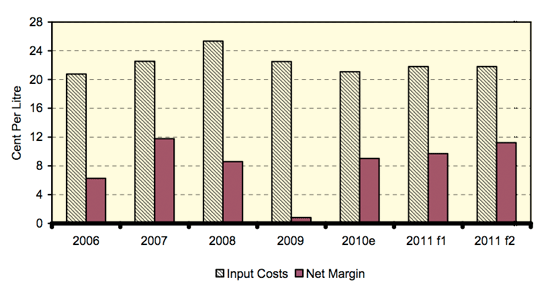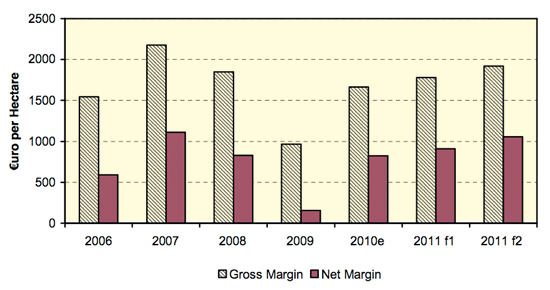



Irish Dairy Outlook For 2011
Trevor Donnellan and Thia Hennessy from Teagasc, forecast the expenditure on various input items in 2011, the annual average milk price that will prevail and the likely profit margins on dairy farms in 2011.The Outlook for Input Expenditure
Feedstuffs – usage and price 2011 The 2010 Irish harvest prices for feed wheat and barley was much improved on the 2008 and 2009 figure due to the shortage of grain on international markets. Prices for cereals in 2010 were up about 60 per cent on the 2009 level.
It is anticipated that milk production will increase by 2 to 3 per cent (a quota binding level) in 2011 relative to the 2010 level, that milk prices will hold firm and that feed prices will rise considerably. Assuming that the unusual weather conditions in 2010 are not repeated, some reduction in concentrate use relative to 2009 may be achievable. Taking these offsetting factors together, it is considered that feed usage levels in 2011 are projected to decline by about 5 per cent in 2011.
Farmers purchasing feed in 2011 can expect to pay considerably more than they did in 2010 due to the elevated 2010 harvest prices. Expectations are that prices for imported feeds will move upwards in 2011 with forecasts of increased prices for cereals of about 5fiveper cent on the 2010 level. Overall, an increase in feed prices of 20 per cent is forecast for dairy farms in 2011. A 20 per cent increase in feed price, coupled with a five per cent decline in feed volume would leave feed expenditure in 2011, 15 per cent higher the 2010 level.
Rising energy prices, rising commodity prices and a contraction in supply capacity provide a basis for higher fertiliser prices in 2011. Global fertiliser consumption has now recovered so that production and consumption are in balance. As a result, fertiliser prices have been on an upward trend since mid 2010 and this trend will continue into 2011. Further upward adjustment in Urea and CAN prices can be expected. International price increases could be of the order of 15 to 20 per cent in 2011 relative to the 2010 level. As a result, the prices paid for fertiliser by Irish dairy farmers in the first half of 2011 will be well up on the 2010 average level.
It is reasonable to expect that fertiliser usage levels in 2011 will be below the 2010 level, perhaps by as much as 10 per cent. With prices up 20 per cent and usage down 10 per cent, this would leave total expenditure on fertiliser up 10 per cent in 2011. Factoring in no change in contractor charges in 2011, would mean that total expenditure on pasture and forage would be up about 5 per cent in 2011 on the 2010 level.
Given that fuel prices are expected to increase further in 2011 an increase in agricultural contracting costs of 5 per cent is forecast. With fertiliser expenditure down forecast to increase by 10 per cent relative to 2009, and contracting costs increasing by 5 per cent, the overall estimated increase in pasture and forage costs for 2010 is 8 per cent.
Following the progressive increase in crude oil prices in 2010, and with natural gas prices also showing upward movement, an increase in energy expenditure on farms in 2011 seems inevitable.
As of December 2010, the average crude oil futures price for 2011 is about $90 pb. This equates to about €69 pb at December 2010 exchange rates which would represent an increase of about 18 per cent on the 2010 level. On this basis, and taking account of the forthcoming increase in the carbon levy, we estimate that the annual average price of farm diesel will increase by at least 12 per cent in 2011 relative to the average for 2010. The rise in fossil fuel prices may lead to an increase in electricity prices of the order of 5 per cent in 2011 relative to 2010. This would leave overall expenditure on energy and fuel up about 10 per cent in 2011 relative to the 2010 level.
The continuing weakness of the Irish economy is likely to stifle any increase in labour costs and general inflation in 2011. Therefore, labour costs are forecast to be unchanged, while expenditure on other direct inputs is projected to decline by 2 per cent in 2011. The increase in fixed costs such as interest changes and depreciation is likely to be no more that 3 or 4 per cent relative to the 2010 level.
The Outlook for Dairy Markets in 2011
As of December 2010 there are no real market negatives in prospect that would point to a decrease in the annual average level of dairy product and milk prices in 2011 relative to 2010. International consumption of dairy products is likely to remain firm. Exports from the Southern Hemisphere may be constrained due to the onset of drought conditions in Australia and New Zealand. Production capacity in grain intensive dairy regions may be stifled by high feed prices.
In the EU some expansion in milk production in Member States where the quota is not binding could emerge in 2011, but equally any additional production could be choked off by higher feed prices in Member States where grass based production is not dominant. European Commission stocks of SMP remain considerable, but at present it seems that there is no strong intention to release these in the short term.
A feature of Irish milk prices over the last three years has been the extent of the volatility that has been observed in comparison with our EU competitors. The Irish dairy sector is a residual supplier to the EU market and also has a significant exposure to third country markets. The sector therefore benefits disproportionately in times of short supply (such as 2007, 2008) and is disproportionately worse off in times of excess supply (such as 2009). In an Irish context the dairy market situation in 2011 look like it may be more in keeping with 2008 with relatively high milk prices offsetting elevated input costs and allowing margins in 2011 to at least be maintained and possibly improved on the 2010 level.
Overall, it is estimated that annual average milk price in 2011 could be 31 cent/litre and as of December 2010, there is the possibility of prices improving further to an annual average of 32 cent/litre if the tight market conditions described above transpire.
The Outlook for Dairy Enterprise Net Margin in 2011
In aggregate, input expenditure is expected to increase in 2011, by approximately 3.5 per cent, but with an offsetting positive movement in milk prices, net margins in 2011 could be at least maintained at 2010 levels and possibly improved on if milk prices rise sufficiently.
In Figure 17 we present two possible 2011 outcomes for net margins based on a 5 per cent increase in milk price to over 31 cent per litre and a 10 per cent increase in milk price to over 32 cent per litre. Under the f1 forecast the average net margin for 2011 is estimated to be 9.7 cpl, which would be similar to the 2010 level. Under the f2 forecast, the average net margin would be about 11.2 cpl, closer to the 2007 level.
Figure 17: Net Margin for Creamery Milk Producers in Ireland in 2006- 2009 with estimate for 2010 and forecasts for 2011

Note: e = estimate
f1 = forecast based on 5% milk price rise
f2 = forecast based on 10% milk price rise
Figure 18: Gross and Net Margin per hectare with forecasts for 2011

Note: e = estimate
f1 = forecast based on 5% milk price rise
f2 = forecast based on 10% milk price rise
Concluding Comments
Following a severe decline in dairy margins in 2009, a significant recovery in dairy margins emerged in 2010. The dairy sector in Ireland benefited particularly from much improved world market conditions and relatively stable overall production costs.
Projected supply and demand conditions suggest that dairy market prices will remain high in 2011, but costs for feed, fertiliser and fuel will increase much as they did back in 2008.
Despite the projected increased cost in 2011, margins should be at least maintained at 2010 levels, and the Irish milk quota should be filled for the first time since 2007/2008.


